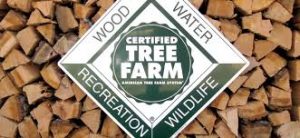Do you remember not so long ago when Harry Potter books were quite the rage? One of those books, Goblet of Fire, sold over 5 million copies. In total, the seven books sold over 450 million copies. Goblet of Fire was 734 pages, or 367 sheets of paper. For that one book, that is 1,835,000,000 sheets of paper. The author, JK Rowling, refused to let her books be published by publishers that didn’t use certified paper. This is just one example of how consumers have driven the market for certified wood.
Many people mistakenly think about the rainforest when we start to talk about forest certification. And although the stories of rainforests disappearing were another driving factor of the certification market, it applies to the woods in our backyards as well. In fact, Wisconsin is one of the largest paper-producing states in the U.S., and as such, many of the paper mills in the state are required to source a minimum percentage of their wood from certified forests.
With all of this in play, Wisconsin decided that it would be a smart business to start investing in certification for forests that were managed by the state. In addition, since the Department of Natural Resources (DNR) manages the Managed Forest Law (MFL) tax program, they could ensure that those woods were managed according to certification standards as well. For the average woodland owner of under 80 acres, having your woods independently certified can be a barrier to entry. However, since the state signs off on a management plan entered into the MFL program, those woods qualify under an umbrella certification.
When we talk to landowners, one of the first things we hear is that they want a healthy woods to pass on to the next generation. They don’t want to do any harm to the trees and the woods as a whole. This fear often leads landowners to think that managing their woods could potentially lead to making their woods worse, and having a timber sale would be a terrible mistake. For this reason many landowners are attracted to the idea of forest certification; landowners have someone looking over any forester’s and logger’s shoulder making sure they are making sound forestry decisions for the long-term health the woods. Even if you are unsure what is sound forestry and what isn’t, someone else with more training is watching out for you. Additionally, for land that is under certification, landowners get a management plan that fits perso nal interests.
nal interests.
Those professionals with more training, in Wisconsin, will be associated with either the Forest Stewardship Council (FSC) or the Sustainable Forestry Initiative (SFI) (for land in MFL, this is the American Tree Farm System). Both FSC and SFI are third party certification programs that are common in the U.S. There are other certifications out there, but these are the two that the state uses. These programs annually audit lands enrolled in MFL, and the DNR has to address any concerns raised by external auditors.
Many landowners are attracted to the MFL program for the tax benefits to the land. However, the access to certification, and the external affirmation of sustainable forest management, are an extra bonus for many landowners who want to feel more certain about their decisions and the future of their woods.
**One final important note, if you are interested in the MFL program because of the certification, note that you have to OPT IN to the program. In a recent audit, the auditors noted that you can’t make someone participate in a certification program. Therefore, DNR had to include a check box on the application where someone could choose to participate in certification. Make sure your forester has you check that box.
